Support Hidden Compass
We stand for journalism, science, history, and hope. Make a contribution to Hidden Compass and stand with us.
“A midwife ought to [have] … a lady’s hand, a hawk’s eye, and a lion’s heart.”
The Experienced Midwife, 1806
Hettie Tom O’Neal snapped awake to urgent knocking at her door. It was a week early; still she’d been waiting on that knock. The floor cold under her bare feet, she found her husband’s cousin Wilson waiting at the door, all nervous energy.
“The baby’s coming,” he said.
That was all Hettie Tom needed to hear. She put on yesterday’s dress, wrapped herself in a shawl, scooped up the basket she had prepared with supplies, and headed out into the Ocracoke night on foot. It was November 4, 1861, when she took her place as the first link in a chain that would last a hundred years.
~~

As the ferry approaches, the island of Ocracoke floats on the horizon. Photo: Megan Dohm.
Ocracoke is a small slip of an island off the North Carolina coast. It’s a place where some of the houses were built with timber stripped from shipwrecks, a place with countless stories of lost sailors, of German U-boats dangerously close to shore, of a beheaded pirate swimming laps around the wreckage of his ship. The memory of storms has soaked into the roots of trees, into people, and into the low tide silt — the kind of storms that demolish two churches, two schools, and 30 houses in less than a day, and leave drowned chickens up in the trees.
The island lends itself to legend … but where strange stories come in with the tide, smaller, plainer stories hide safely behind the lore.
It is also a place where people have been making do for themselves for generations. About two hours from the mainland by ferry, many inhabitants lived their lives here from cradle to grave — building businesses on the water, growing gardens, hosting dances and nursing grudges — with relatively little connection to or notice from the outside world.
Perhaps Hettie Tom (later known as Aunt Hettie Tom, a dual sign of respect and familiarity) brushed aside her nerves that night as she walked through the door. She’d given birth to her own children, so she was familiar with the mechanics — but she had never delivered another woman’s child before. Still, there was hardly time for second-guessing with a woman in labor and an overly helpful mother-in-law to shoo away.
Was the labor easy or difficult, long or short? What time did the baby arrive? What was her weight and length? Who was in the room? Those details are lost. Instead, we have an outline documented in a letter: A birthdate. A name, Polly Ann. And with the new baby, a new limb on a family tree. Everything else is forgotten.
~~
162 years later, I watched the island appear on the horizon. As my ferry approached, Ocracoke didn’t get any bigger — only closer. I’d spent enough time there before to know the general lay of the land: the village (year-round population: about 1,000) and its sensibly named roads (the lighthouse on Lighthouse Road, etc.), the beach outposts, the two-lane highway that runs the length of the island. At the height of tourist season a car is too bulky; better to navigate the village by foot or bike down lanes that smell like warm, dusty earth.

The quiet dirt lanes of Ocracoke are best navigated by bike and on foot. Photo: Megan Dohm.
Ocracoke is now mostly a patchwork of nature preserves, and the vegetation is hardy, surviving on limited resources — twisted live oaks, tough grasses that can be used for various cures, and trees whose bark can numb a toothache. During warm months, cicadas shrill and whir a lullaby that blankets the entire village.
The island lends itself to legend by its distance from the mainland, its ruggedness, the endurance of its people. Old family names have lingered here since the 1790s. They live on in street signs, old gravestones, and current inhabitants — Braggs and Howards, Garrishes and Scarboroughs, Williams and Neales (later O’Neal, pronounced with emphasis on the O, always). Draped across the “Graveyard of the Atlantic,” the island sits in a stretch of water where ever-shifting sandbars grounded and wrecked the first explorers, passing merchant ships, and local sailors alike. Roughly 2,000 wrecks are recorded in these waters — launching about a thousand and one ghost stories. But where strange stories come in with the tide, smaller, plainer stories hide safely behind the lore.
~~
In 1849, at age 27, Hettie Tom O’Neal lost her husband to the sea after his pilot boat capsized. According to a letter written by her great-grandson to the state archivist, she supported her children by carding wool, spinning and weaving. Her path from textiles to midwifery is unclear. Perhaps delivering her own children was a formative experience, or maybe her natural gifts simply met an ever-present need, but after training with Dr. Thomas Dudley on the nearby island of Portsmouth during the Civil War, she became the midwife and nurse for both islands.
Armed with her training and a book Dr. Dudley had gifted her — likely Aristotle’s Works, a guide to basic sex education, fertility, childbirth, and home remedies — Hettie Tom would spend almost four decades present at the births of at least 447 babies, one of them Polly Ann’s son. Since Ocracoke was without a doctor more often than not, she also tended to many ailments on the island.
A descendant lost the book where she recorded deliveries, so we are left to piece together Hettie Tom from memories of memories — a tiny basket she carried with her on visits, a single portrait — and also from the series of women who followed in her footsteps. Over the next century these women wove in and out of the most important moments in their fellow islanders’ lives.
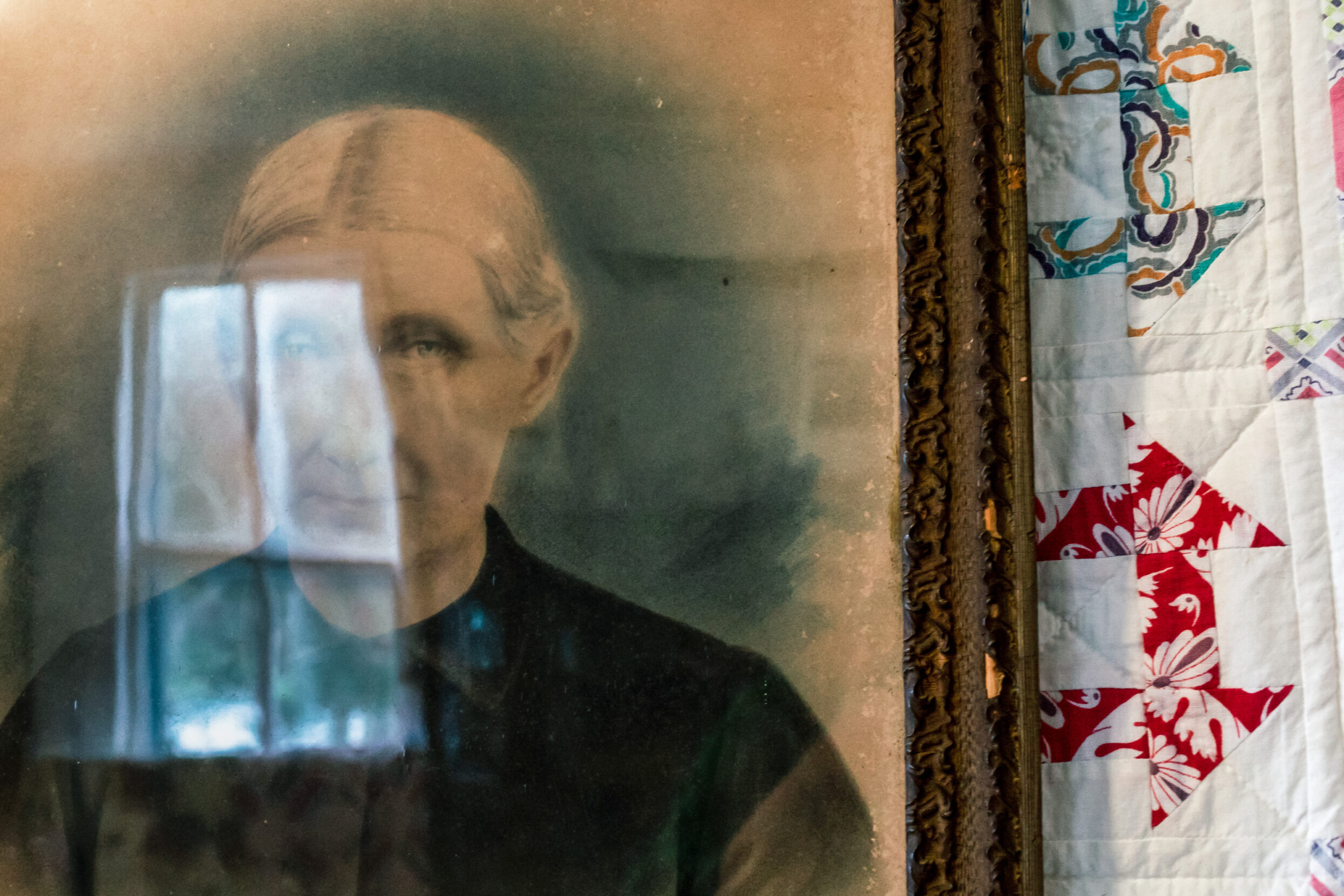
The only known portrait of midwife Hettie Tom hangs in the Ocracoke Preservation Society. Photo: Megan Dohm.
~~
My home base on Ocracoke was a bed and breakfast, an old house with sloping floors and doors left ajar during the day to catch the breeze. Recently recovered from hurricane damage, the walls wore fresh coats of paint paired with framed old maps and illustrations of ships.
My first morning on the island, I met Alton Ballance, the inn’s proprietor. He was an unimposing man with silver hair — quiet but at ease in a dining room full of strangers. A lifelong Ocracoker, Ballance had the forethought to interview older islanders before memory faded completely, and it was his 1989 book that first introduced me to Hettie Tom and the midwives. I assumed from past trips and unanswered emails that he wasn’t interested in an interview, but he offered a quiet place to stay and good winter rates — and I had plenty of mornings to linger over breakfast in hopes of striking up a conversation. Ballance gently stepped around my hints, made breakfast, put coffee on, and then made himself scarce.
Each day, I scoured the island, talking to shopkeepers and bartenders, rifling through tall stacks of paper, and tracing paths to one dead end after another.
They disappeared not because their work wasn’t important, but because it wasn’t historic.
Some days I found myself at the Ocracoke Preservation Society, and by my third visit I knew I was welcome to let myself past the pirate flag barrier and walk up the narrow staircase to the archive room. Stationed in a historic home overlooking the harbor, the Preservation Society has a small museum on the first floor, walls covered with relics — duck decoys, household items, uniforms — and a corner about the midwives themselves.
Up in the archive room, I rummaged through every piece of paper that seemed like it might be related — even tangentially — to the midwives. I pulled books off the shelves, folders from a stuffed file cabinet, and combed through boxes of photographs and business cards. As ferries came and went, blasting their horns, I skimmed and photographed anything I thought might be useful at a near frantic rate. Most of the material I thumbed through was intriguing but not what I was looking for (homicide, Civil War, shipwrecks galore). But over the hours I slowly found relief in interview transcripts, National Park Service write-ups, articles printed from local historian Philip Howard’s blog, and student newspaper interviews with old-timers, letters and images blotched and frayed by microfilm and a copy machine.
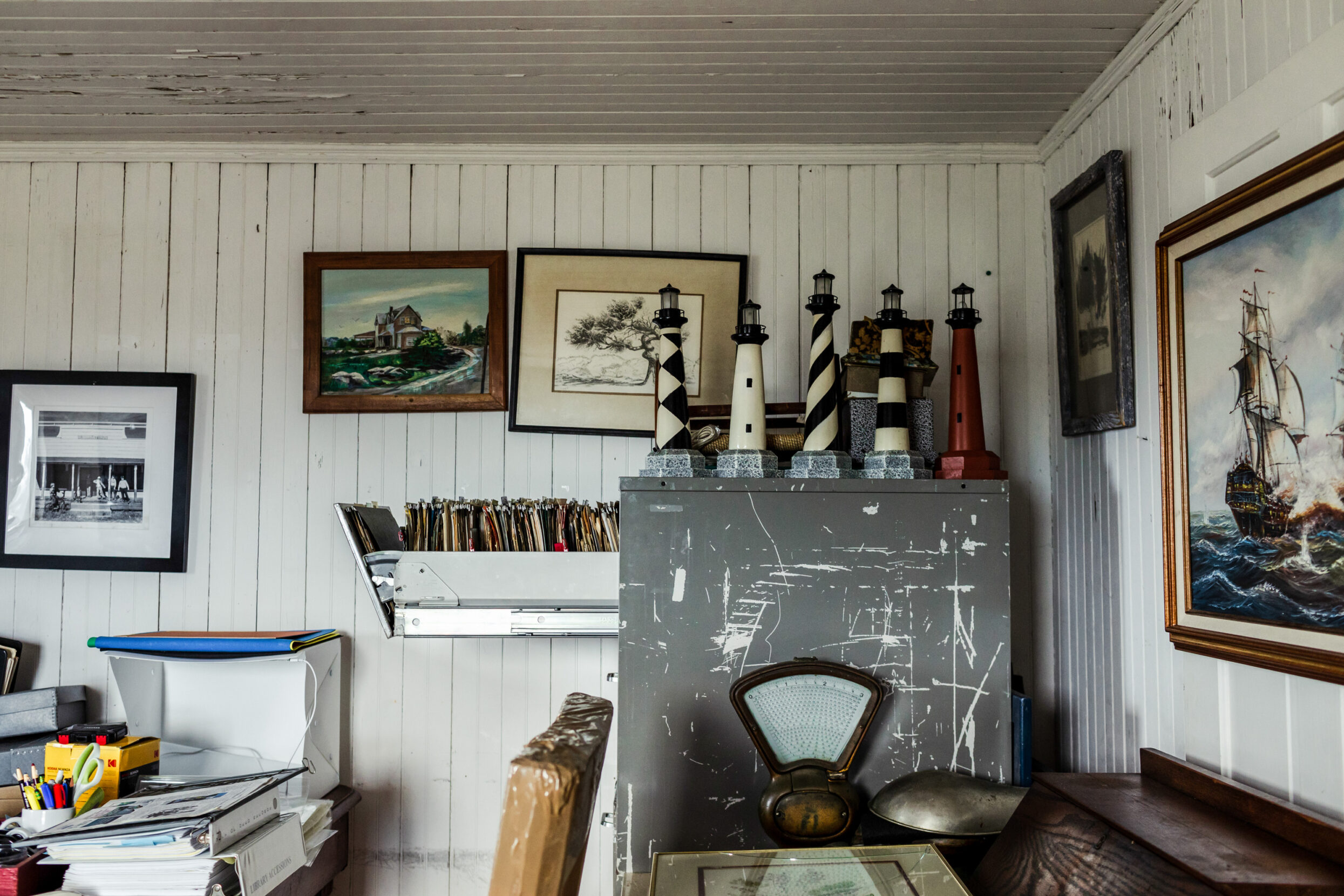
Filing cabinets in the archive room of the Ocracoke Preservation Society preserve interview transcripts, newspaper clippings, and photographs that divulge the history of the island. Photo: Megan Dohm.
There were just a few snippets about the women who took over from Hettie Tom: her late husband’s second cousin, Mary Jane Garrish, and, perhaps, Mehettable Bates. Then came Garrish’s sister Charlotte — Aunt Lot to most of the island. Each new midwife, it seemed, took on responsibility for the island’s mothers and children with less of an official anointing and more of a slow, natural fade from one era to another.
By the time Aunt Lot lost count of how many babies she’d delivered, she was surely well-practiced — equal parts caring and authoritative. Reading transcripts, I could picture her bustling about, hair pulled back, sleeves rolled up.
After a baby was introduced to their parents, she’d cut the umbilical cord and deftly wrap the stump with a raisin and scorched cloth, which was supposed to help dry out the umbilical cord more quickly. But her work was not finished with the baby’s safe arrival. She stayed with the family for days to make sure everything was in order — rocking the baby, cleaning the stained bedding, and keeping the mother in bed with just a stern look.
And, in rare moments of repose, she indulged in snuff.
During the years she practiced, decades before a paved road came to Ocracoke, children started leaving the island for a better education and for work, the Wright brothers’ new plane lifted off at nearby Kitty Hawk, and the outside world teetered on the brink of the Great Depression. Aunt Lot navigated the changing world with her husband and four children. Like many islanders at the time, their home had enough, but not plenty. Her daughter, Sarah Ellen Gaskill, told a historian that out of roughly 100 deliveries Aunt Lot never lost a baby. Despite this accomplishment, Gaskill wasn’t sure her mother could even write her own name.
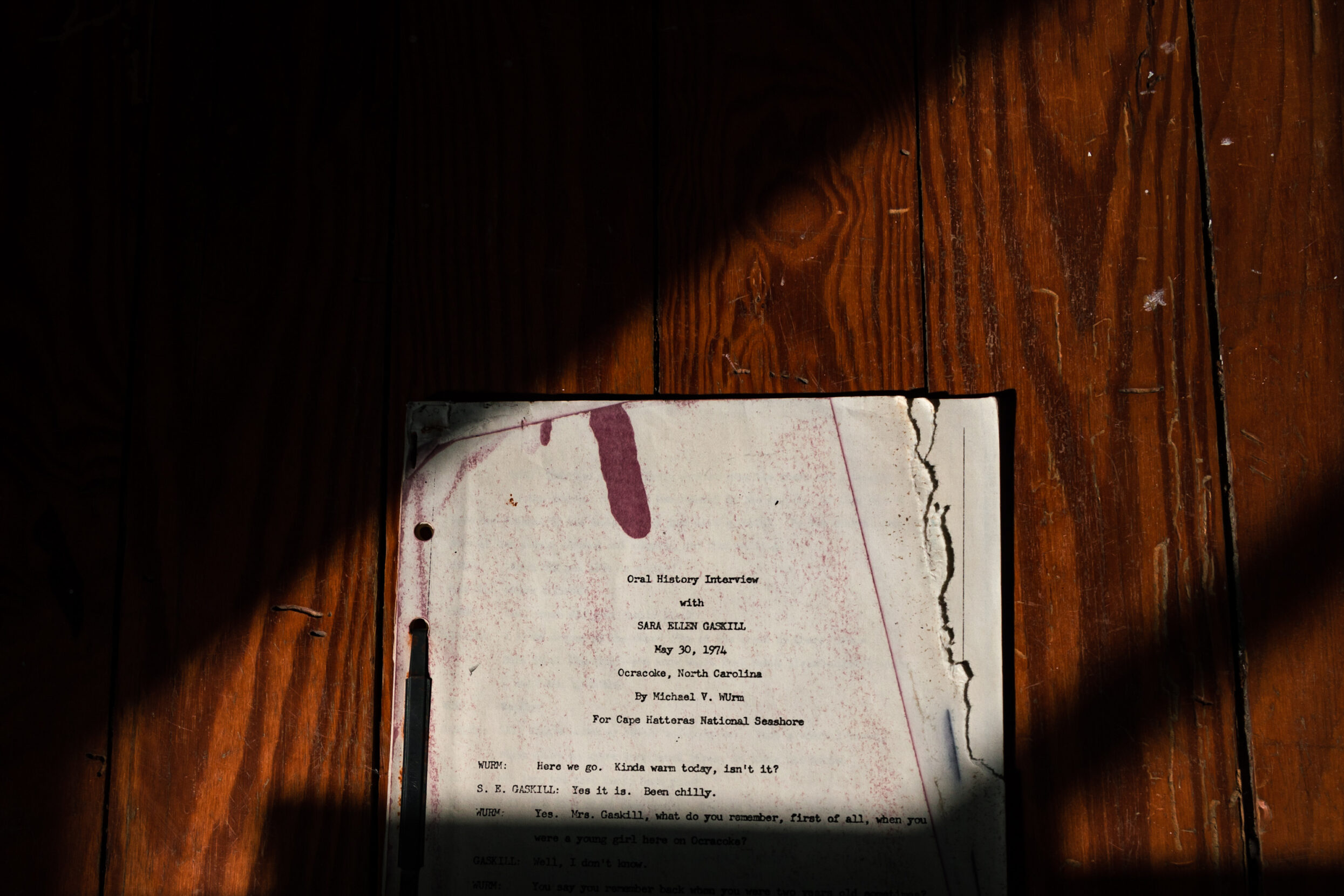
A transcript of an interview with Sarah Ellen Gaskill, dated May 30, 1974. Photo: Megan Dohm.
~~
Joyce Spencer, 87, still lives on the island where she was born. She resides with a stripy orange cat named Miss Daisy in a house recently hoisted on stilts out of storm surges’ reach. Spencer is not certain who delivered most of her seven siblings, but she’s pretty sure it was Aunt Lot.
Spencer says her mother always delivered on the island, first in “grandmama’s” house, then in her own.
“When Mama had the twins, she like to died because they couldn’t get the afterbirth … back then, them days you didn’t get up. You laid in bed for a week after you had a youngin.” As she speaks, Spencer’s accent plays at the edges of her words, something like old English melded with eastern North Carolina southern lilt. High Tider brogue. It’s specific to the area, all but faded on the island except amongst the old-timers.
Her mother pleaded for permission to stand up, and her attendants relented only at the insistence of Spencer’s father. The afterbirth passed, and the birth was officially considered a success. Spencer is not sure if it was hours or days that passed between birth and afterbirth — there is much she did not ask her mother about her experience and much her mother never offered. Mothers on Ocracoke seem to have been modest about the birth process, attended by a midwife and maybe a mother or older woman in the family.
By the time Spencer started having her own children in the 1950s, she (like many other island mothers) delivered in a hospital on the mainland, traveling weeks before her due date to stay with relatives near the hospital. In Spencer’s generation, birth control pills arrived on the island, a change rapidly reflected in smaller average family size.
Except for one sibling who passed away at seven years old from diphtheria, Spencer’s family’s medical history was uncomplicated. For all the births on the island, the leading cause of child mortality seemed to be disease, young deaths marking a smattering of gravestones.
“I think sometimes how Mama ever did it,” she said, about all of it – childbirth, six children born within five years, the loss of one child, raising a large family on a slim income.
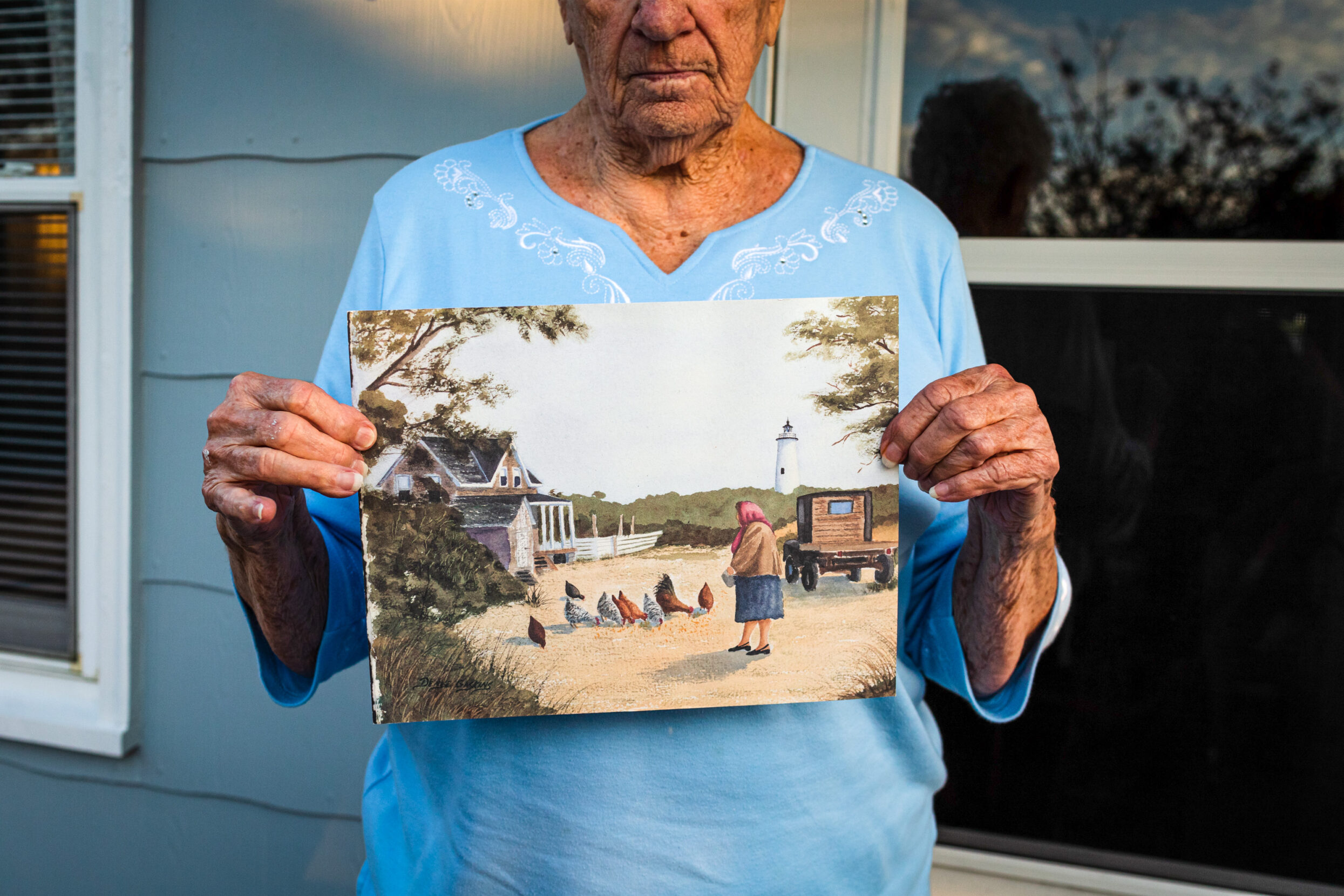
Joyce Spencer holds an illustration of Kathleen Bragg feeding chickens in front of her home. Photo: Megan Dohm.
~~
Carefully sidestepping fire ant piles, I wandered all the graveyards I could find scattered across the village, leaning over fences to get a better look at text carved in stone. Relatives chose what should be remembered about their loved one’s life and death: their birth, title (military rank, “Mother,” “Father,” “Daughter of”), a snippet of a poem or Scripture. On newer headstones, the carving is still crisp; on the oldest markers there is nothing left but a series of little ridges that used to be letters telling us someone lived and died here, but little else.
When the midwives and their loved ones died, they took with them memories and knowledge that were too small to memorialize — the shape of Hettie Tom’s hands, the trick she had for calming the husband of a woman in labor, the way she busied herself with cleaning when she was staving off impatience with a due date too far gone. Details like this could bring the midwives back to life, could put flesh on the bones of their stories and commemorate the extraordinary lives of women who had no idea they were remarkable.
On my morning of graveyard wandering, I began to come to terms with the fact that many, many artifacts from the midwives’ lives are simply gone. They disappeared not because their work wasn’t important, but because it wasn’t historic.
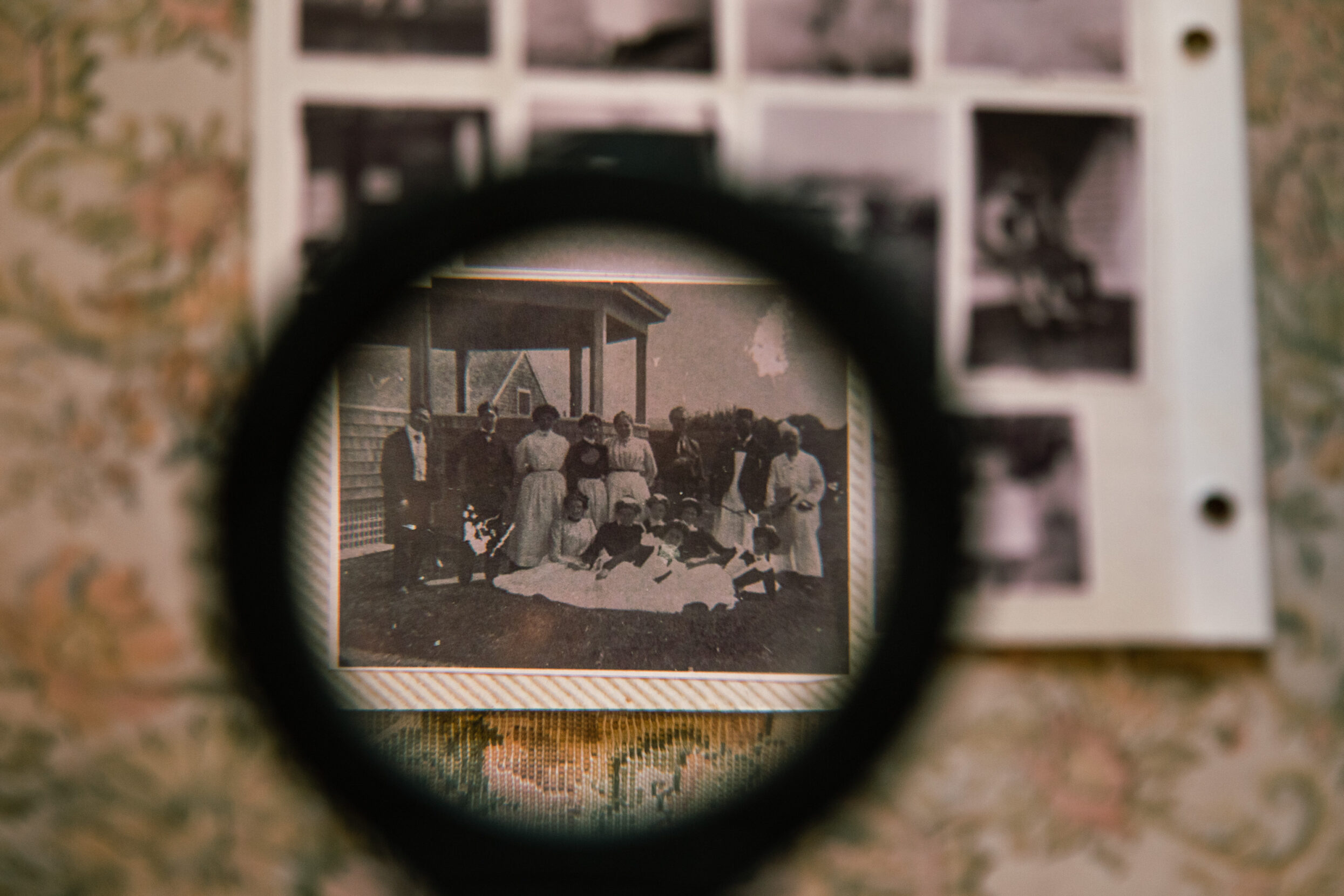
A group of doctors and nurses gather at the nearest hospital to Ocracoke on the neighboring island of Porstmouth. Over the years, the hospital also served as Civil War barracks, a dancehall, and a telegraph station before burning down in 1890. Photo: Megan Dohm.
~~
My last morning in Ocracoke, as I settled the bill for my room with Ballance, I finally got up the courage to ask him directly about the story. We were in the kitchen, the smell of coffee just on the brink of burning in the air. Leaning against the doorway, I stumbled over a too-long question that ended in,
“How do I get this right?”
The question cracked open a door.
One thing people fail to notice, Ballance told me, was the risk of having a baby so far from help. There wasn’t even the hope of a hospital back then, and treatments could be dubious; he offered a story of finding a green glass bottle in the room where his mother was born, a syrup used to treat fussy babies that they later found out contained morphine.
His brother Kenny stepped in through the porch door. He’s a retired law enforcement officer, baker of pies for a local restaurant, and founding member of the local rescue squad who himself has delivered a baby — in a helicopter. The brothers told me that while Aunt Lot had delivered their father, their mother was delivered by Aunt Hettie Tom’s granddaughter, Miss Lola.
~~
Lola Wahab was the first midwife on Ocracoke to have documented training from a more official source — a correspondence course from the Chicago School of Nursing. Like the midwives before her, Miss Lola applied her knowledge, whether from an official handbook or handed down by tradition, to remedy myriad ailments.
In his book, Ballance chronicled the treatments passed down by Miss Lola, Aunt Lot, and the other women in the area. For calming the pulsing throb of a stingray wound, cut open a black chicken and place it directly on the wound. For cooling a fever, sassafras leaves placed on the forehead. And for common colds, a mixture of sugar and turpentine. The women’s treatments, often coaxed from the natural world, saw the people of the island through.
Chester Lynn, an Ocracoker born and raised, scavenger of artifacts, and keen plant expert, says the process of passing on the knowledge of what plants to use or leave well enough alone isn’t simple.
“There’s no way of explaining that. You have to learn that through education of people, you know?” Lynn was still a young boy when one of the last links in the chain of island caregivers, Kathleen Bragg, was the school nurse.
~~
The granddaughter of a drowned ship’s pilot, Kathleen never married or had children of her own. She returned to Ocracoke a few years after graduating first in her class at nursing school and spent the rest of her life on the island. After an incident involving one vaccine needle (maybe two) broken off in a student’s arm, Kathleen earned the nickname “Dagger Lilly” among the town’s schoolchildren, who bolted when they saw her coming. Even today, islanders who knew her shudder at her name. Still, they echo the praise for Kathleen each midwife received: When someone called, she came.
Over the years she treated typhoid fever, a ruptured appendix, and blood poisoning. According to a newspaper clipping from 1958, while sick in bed herself Kathleen directed treatment during a flu epidemic that hit 300 out of 500 islanders. Throughout all of it, she delivered more than 100 babies.
And when Kathleen died in 1975, Elsie Garrish — the last link in the chain — was with her.

Chester Lynn’s family Bible — which was salvaged after Hurricane Dorian in 2019 — documents his family’s lineage. Photo: Megan Dohm.
~~
On the eve of her most remarkable delivery, I imagine Elsie Garrish avoided the creaks in the floor, an old habit for late night treks through the house. She picked her way to the door around chairs and loose items the Garrishes stowed in the front room to keep them out of the incoming storm’s reach. The mother of an expectant woman who lived nearby tumbled in, dripping. With just a few words – labor pains, no boats leaving – Elsie reached for her coat.
She walked toward the expectant mother’s house, one arm protecting her face from driving rain. Yellow light spilled out of houses, illuminating tree branches bucking wildly, trunks swaying like a mother trying to calm a colicky baby. Elsie was not afraid of storms — she’d weathered too many, and anyway she was not the fretful sort — but she could not hear wind like this without thinking of her little brother. He had died as a child of colitis during a storm not unlike this one, his death cementing her interest in medicine. As a registered nurse, when the need arose she could certainly roll up her sleeves and manage.
Details like this could bring the midwives back to life, could put flesh on the bones of their stories and commemorate the extraordinary lives of women who had no idea they were remarkable.
As Elsie arrived at the house, the tide rushed up the road as if it had been searching for them. She waded through murky, knee-deep water to the front door, peeled off her wet shoes, scrubbed her arms up to her elbows, and went to work.
When gray dawn stretched across the island, the woman’s contractions had intensified and the storm made landfall. Elsie spotted water pooling in the front corner of the room where the floor dipped. She’d learned a lot in nursing school, but how to move a laboring woman to the second story of a home in the middle of the worst storm of the year was not one of them. Elsie gave the woman a sip of water from a Dixie cup, then said,
“Let’s see if it’s time to push.”
Despite howling wind and pounding rain, the baby arrived safely on the first floor at the height of Hurricane Hazel, the deadliest hurricane of 1954 and the strongest in recorded state history.
~~
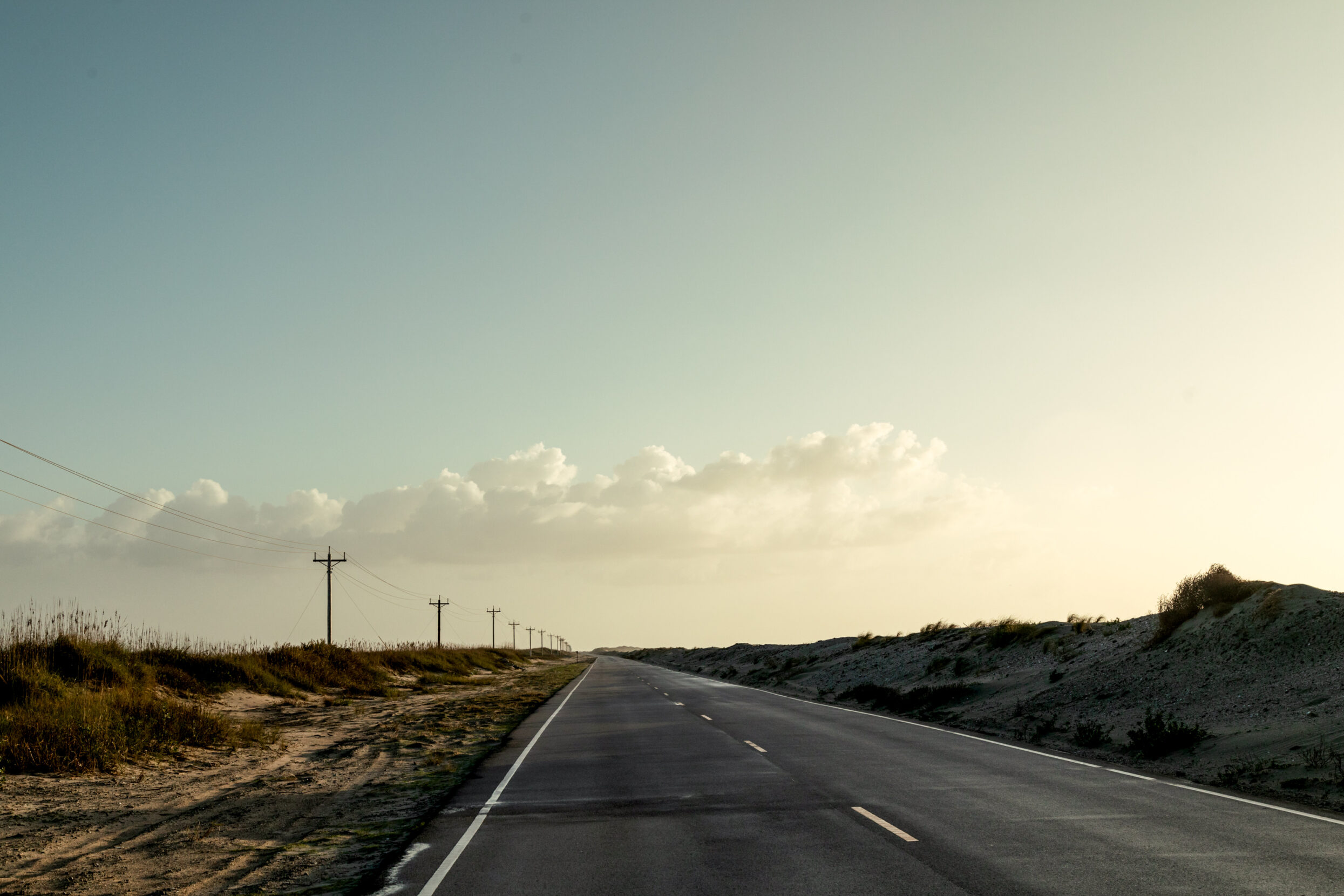
Highway 12, the main road on the island of Ocracoke. Photo: Megan Dohm.
Standing on the island, feeling the wind pick up, watching dark clouds build on the horizon, and realizing I had nowhere to hide, all the big stories immediately shrank to life-size proportions. Storms are not metaphors, a test of resilience or a source of lore; they’re just rain and wind sweeping indifferently over homes, family bibles, priceless heirlooms. There is simplicity to island life — but there is also a vulnerability to the elements that instills in people a sort of vinegar.
Resilience is less a virtue than a necessity.
In Elsie’s lifetime, Ocracoke opened up to the rest of the world. The island got a paved road, regular ferry service, electricity, phone service, and — weather permitting — access to hospitals via helicopters. When the first dedicated doctor in a hundred years came to Ocracoke, Elsie served on the committee to create a proper health clinic instead of leaving the doctor to run the practice from his first floor and front porch. Once the clinic was built, Elsie served on its board, and Ocracokers led the charge to expand it; eventually the station wagon used as an ambulance was replaced by the real thing.

Newspaper clippings document the arrival of the first dedicated doctor in a hundred years to come to Ocracoke. Photo: Megan Dohm.
The health center is still open five days a week. Although their regular doctor moved away from the island last summer, there are nurses, nurse practitioners, and medical assistants on staff, in addition to a doctor who makes a two-hour-plus trip from the far end of Roanoke Island twice a week. Expectant parents still have a longer trip to a hospital than most, but the journey is easier than it’s ever been.
~~
Thirty-seven years and two days after her first delivery, Aunt Hettie Tom delivered her last baby — a little girl named Iva — on November 6, 1898. Hettie Tom died three months later. Her coffin was carried to the graveyard off Howard Street and buried under ground dappled by late morning light.
My mind fills in the unknown gaps from the funeral day: a small group of mourners at the graveside, a deacon, who she had delivered decades before, starting a hymn pitched too high, the tune carried away by cold wind. The preacher speaks the words, “Ashes to ashes, dust to dust,” over a woman who only weeks earlier had been busy with spinning and weaving and bringing new life into the world.
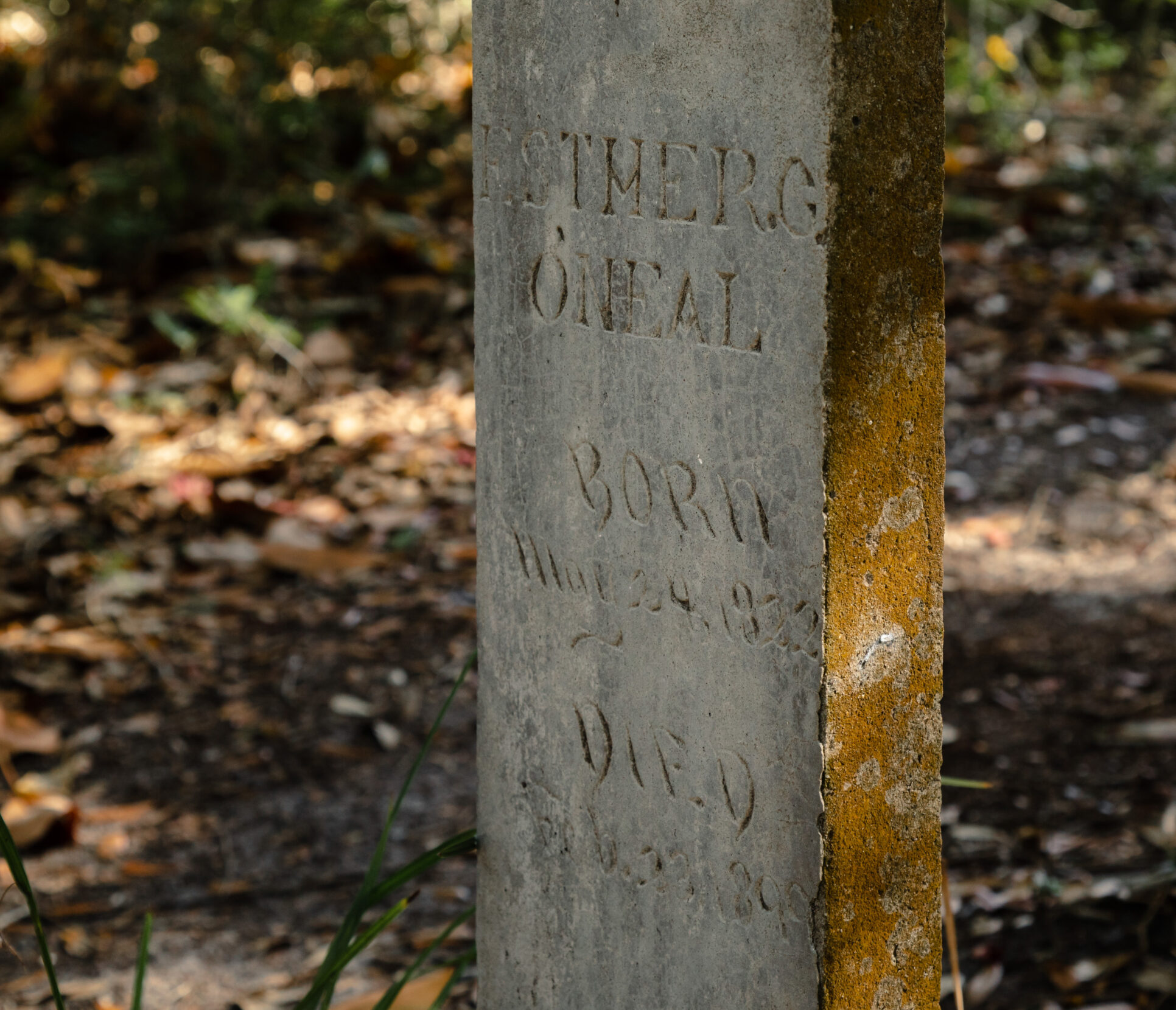
The gravestone of Hettie Tom, at the graveyard off Howard Street, on Ocracoke. Photo: Megan Dohm.
In November of 2022, the letters on her marker are starting to fade, filling in with moss. Visitors have left one nickel and three crusty pennies balanced atop the stone, small tributes to the first link in the chain. Hettie Tom’s simple gravestone makes no mention of her calling. The legacy of Hettie Tom and the women who followed her is not emblazoned in history or carved in stone.
Instead, their legacy is carved in family trees.
Megan Dohm
Megan Dohm is a writer and photographer based in North Carolina who enjoys tracking down 18th-century court documents.
Never miss a story
Subscribe for new issue alerts.
By submitting this form, you consent to receive updates from Hidden Compass regarding new issues and other ongoing promotions such as workshop opportunities. Please refer to our Privacy Policy for more information.



